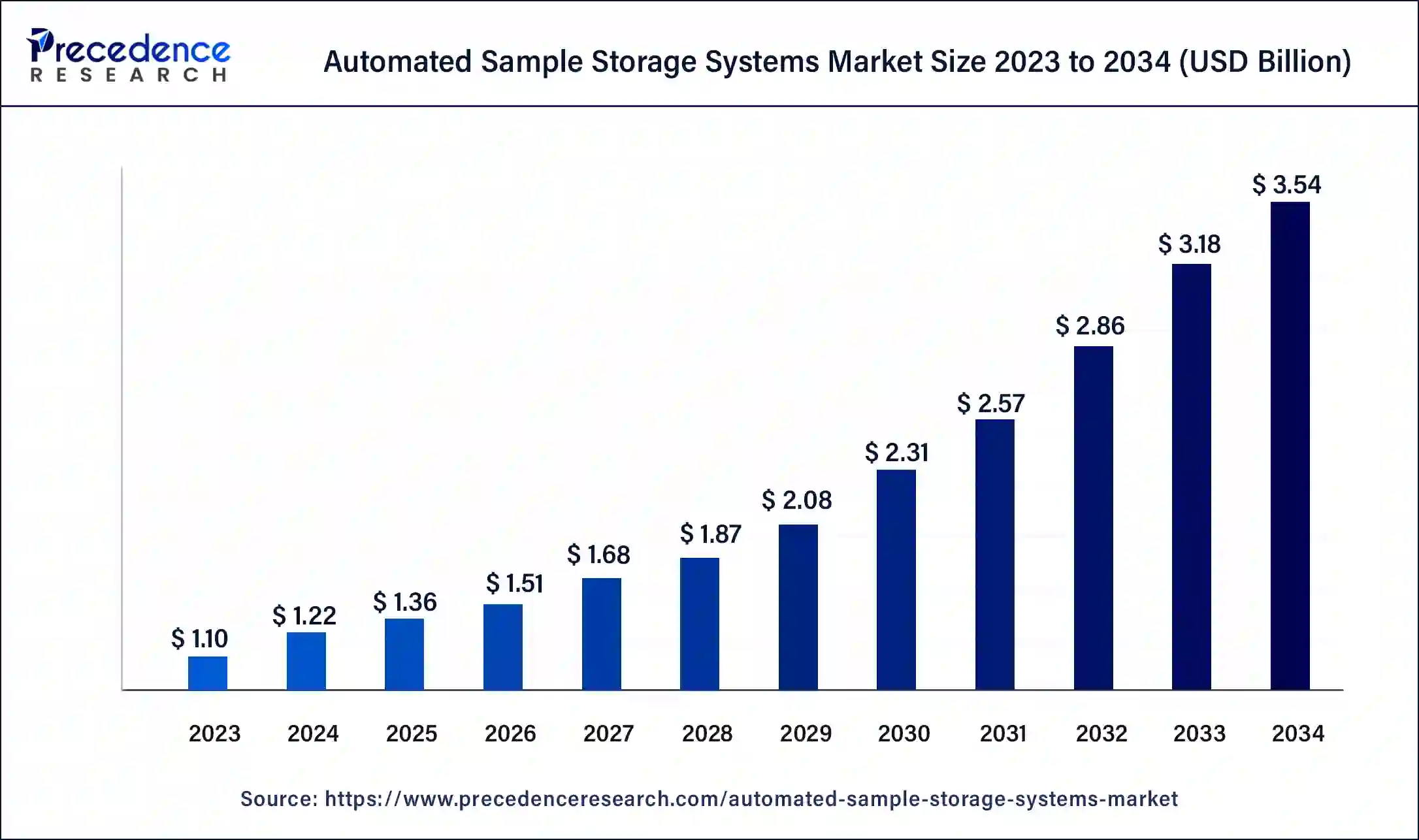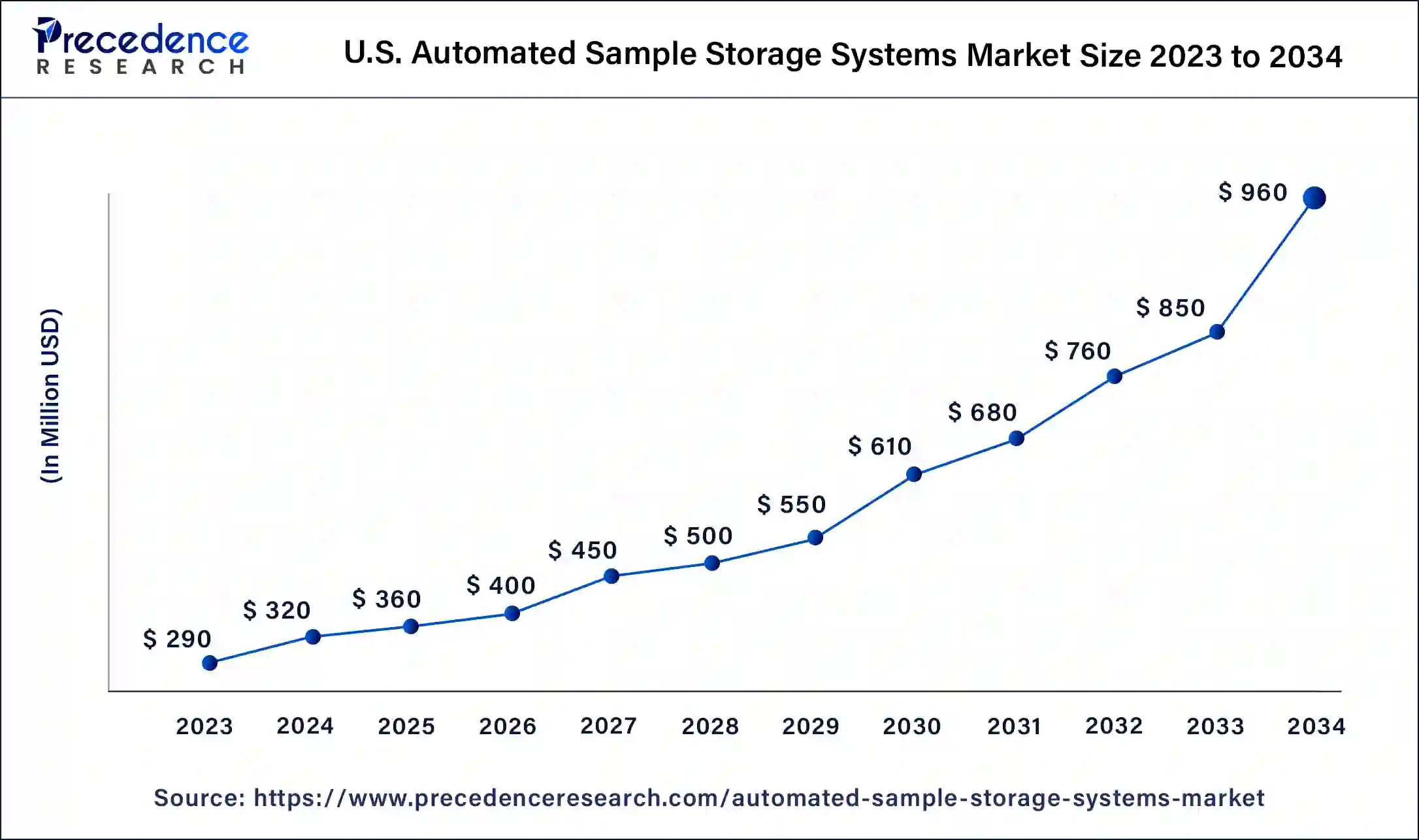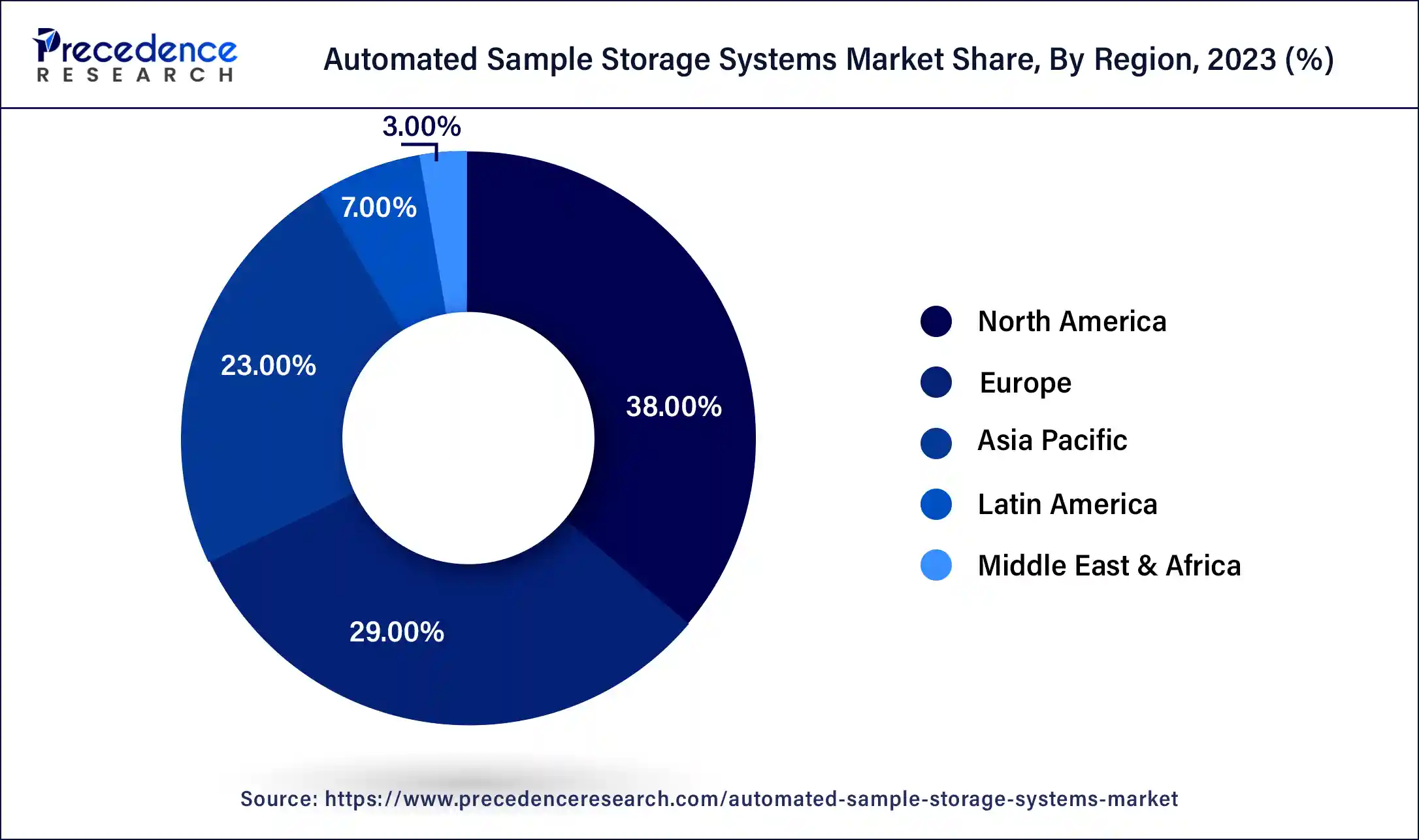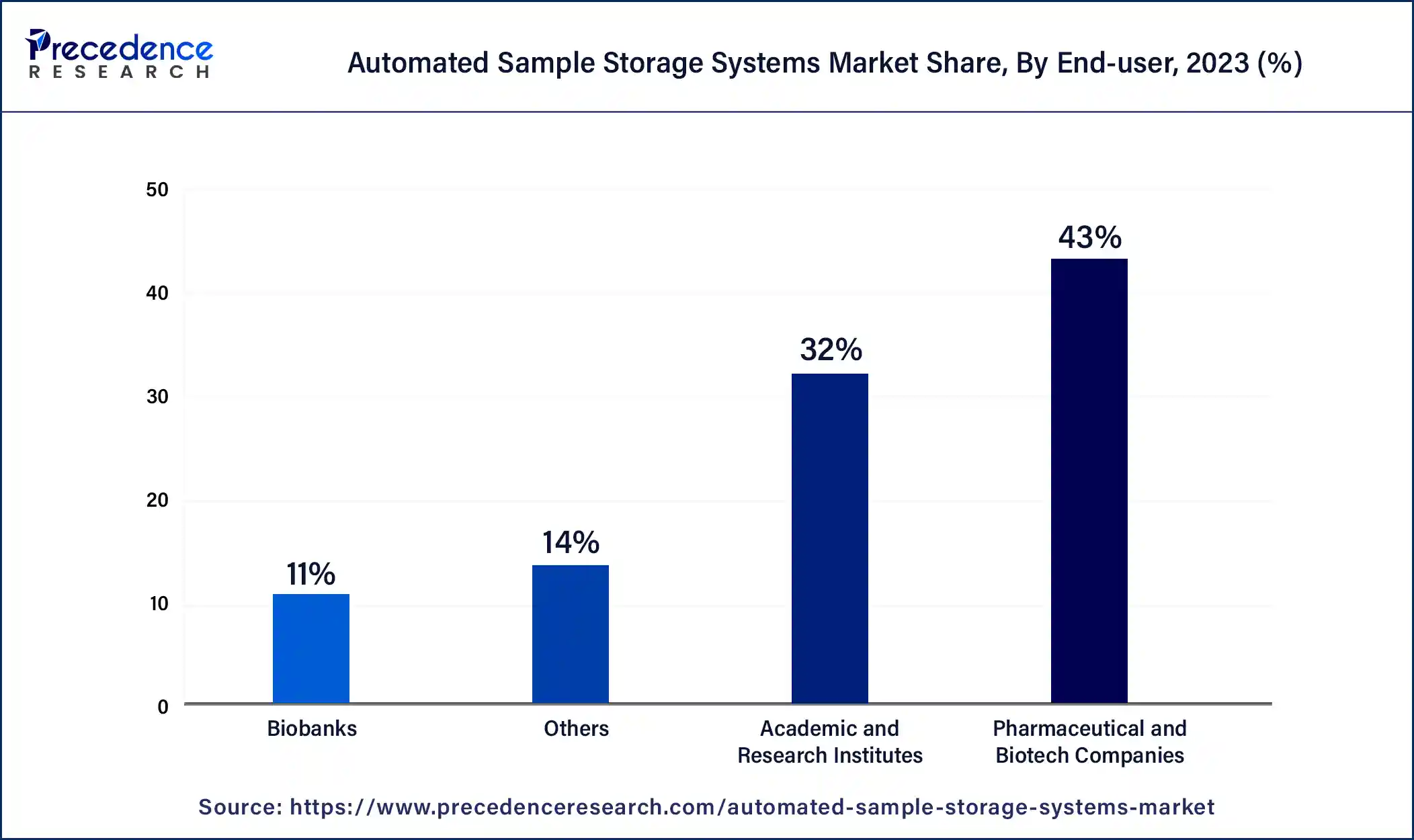List of Contents
What is the Automated Sample Storage Systems Market Size?
The global automated sample storage systems market size is estimated at USD 1.36 billion in 2025 and is predicted to increase from USD 1.51 billion in 2026 to approximately USD 3.54 billion by 2034, expanding at a CAGR of 11.24% from 2025 to 2034. The automated sample storage systems' benefits include helping to maximize sample accessibility and integrity, strong refrigeration designed for the protection of samples from disasters, and automated handling helps to improve sample protection and minimize sample temperature cycling.

Automated Sample Storage Systems Market Key Takeaways
- In terms of revenue, the global automated sample storage systems market was valued at USD 1.22 billion in 2024.
- It is projected to reach USD 3.54 billion by 2034.
- The market is expected to grow at a CAGR of 11.24% from 2025 to 2034.
- North America dominated the automated sample storage systems market with the largest market share of 38% in 2024.
- Asia Pacific is estimated to be the fastest-growing during the forecast period of 2025-2034.
- By product type, the automated biological sample storage systems segment dominated the market with a 37.10% share in 2024.
- By product type, the automated compound storage system segment is expected to grow at the highest CAGR of 11.20% over the forecast period.
- By end user, the pharmaceutical companies/biotech segment held a 41.50% market share in 2024.
- By end user, the biobanks / CROs / CDMOs segment is expected to grow at the highest CAGR over the forecast period.
- By application, the drug discovery & development / clinical trials segment dominated the market with 39.60% share in 2024.
- By application, the personalized medicine/genomics & proteomics segment is expected to grow at the highest CAGR of 13.50% during the forecast period.
- By automation level, the mid-level automation segment held a 44.20% market share in 2024.
- By automation level, the advanced / AI-based automation segment is expected to grow at the highest CAGR of 14.40% during the forecast period.
How is AI Revolutionizing the Automated Sample Storage Systems?
AI-based automated sample storage systems help reduce many manual tasks and the complexity of traditional sample storage systems. The benefits of the use of artificial intelligence (AI) in automated sample storage systems include workload optimization, intelligent data tiering, and automated provisioning. Committed storage personnel may spend less time managing and monitoring storage systems as a result. AI-based automated sample storage systems can help to support recovery capabilities and intelligent backup.
- In February 2024, the BioArc Ultra (the ‘Ultra'), an advanced, automated solution for high-density, eco-friendly ultracold sample management, was launched by Azenta, Inc. This solution helps to provide a new performance level for large-scale sample management with the capacity to change the landscape of biorepositories. The Ultra offers significant operational efficiency advantages, including electricity and labor cost savings and footprint compared to other traditionally available systems.
U.S. Automated Sample Storage Systems Market Size and Growth 2024 to 2034
The U.S. automated sample storage systems market size is exhibited at USD 360 million in 2025 and is projected to be worth around USD 960 million by 2034, poised to grow at a CAGR of 11.61% from 2025 to 2034.

North America has contributed the biggest market share of 38% in 2024. Rising demand for laboratory automation, the presence of many market players, and supportive government initiatives contribute to the growth of the market in North America. A strong supplier network and easy availability of advanced technological products contribute to the growth of the market. The U.S. country is leading the growth of the market in the North American region. Strong refrigeration is designed for the protection of samples from disasters by key market players in North America.
- In May 2024, in the U.S., the four high-capacity Hamilton BiOS automated storage systems will be installed in UK Biobank's new Manchester Science Park Headquarters, announced by Hamilton Storage Technologies, Inc. It provides automated ultra-low temperature freezers for sample storage.

Asia Pacific is estimated to be the fastest-growing during the forecast period of 2025-2034. Significant investments from key players, a high number of patients to target diseases, and proceeding startups help the growth of the automated sample storage systems market in the Asia Pacific region. Improved ergonomics, tighter inventory control, improved picking throughput, increased picking accuracy, no need for manual search for samples, minimized sample temperature cycling, reduced costs and labor requirements, and improved floor space use can help the growth of the market in the Asia Pacific region.
Hamilton provides exact storage capacities with BiOS minus 80°C lab freezer.
| Example Capacities (Standard Racks) | BiOS M | BiOS L | BiOS XL |
| Hamilton 0.3mL | 906K–10.5M | 1.47M–17.0M | 3.26M–17.4M |
| Micronic 0.5mL | 661K–7.65M | 1.16M–12.5M | 2.40M–12.7M |
| Hamilton 0.6mL | 634K–6.8M | 1.00M–10.8M | 2.07M–11.0M |
| Hamilton 1.0mL | 392K–4.53M | 661K–7.65M | 1.47M–7.81M |
| Hamilton 2.0mL | 208K–2.41M | 343K–3.96M | 762K–4.05M |
| Nunc 5.0mL | 104K–1.14M | 166K–1.91M | 367K–1.95M |
Market Overview
The automated sample storage systems market refers to the computer-controlled storage devices that store samples like chemical compounds and biological samples used in many end-use industries, including life sciences, medical material management, seed storage and management, chemicals, etc. These systems help laboratory facilities retrieve and store samples effectively as necessary. The automated sample storage systems appear to offer the benefits of preserving sample quality, significant efficiency, and space-saving. The advantages of automated sample storage systems include streamlined sample management, energy efficiency, resource-saving with automation, and efficiency in sample retrieval.
Automated Sample Storage Systems Market Growth Factors
- The advantages of automated sample storage systems include streamlined sample management, energy efficiency, resource-saving with automation, and efficiency in sample retrieval that help the growth of the market.
- The benefits also include it helps preserve sample quality, significant efficiency, and space saving which help the growth of the market.
- It also helps to improve safety features and reduce tedium which helps to the growth of the automated sample storage systems market.
- Automated sample storage systems applications include environmental and agricultural research, forensic science, genomics and proteomics research, clinical diagnostics, pharmaceutical and drug discovery, and biobanking and biorepositories, which contribute to the growth of the market.
Market Scope
| Report Coverage | Details |
| Market Size by 2034 | USD 3.54 Billion |
| Market Size in 2025 | USD 1.36 Billion |
| Market Size in 2026 | USD 1.51 Billion |
| Market Growth Rate from 2024 to 2034 | CAGR of 11.21% |
| Largest Market | North America |
| Base Year | 2025 |
| Forecast Period | 2025 to 2034 |
| Segments Covered | Product, Sample, End-user, and Regions |
| Regions Covered | North America, Europe, Asia-Pacific, Latin America, and Middle East & Africa |
Market Dynamics
Driver
Rising investments in pharmaceutical and biotech industries
The rising investments in pharmaceutical and biotechnology industries contribute to the growth of the market. Rising demand for managing and storing large volumes of samples, including compounds and specimens, across the healthcare, biopharmaceutical, and pharmaceutical industries contribute to the growth of the automated sample storage systems market. The use of automated sample storage systems in pharmaceutical and biotech industries helps to improve remote monitoring, reduce equipment maintenance costs, and prevent failure. These factors help to the growth of the market.
Restraint
Limitations of automated sample storage systems
The limitations of automated sample storage systems include the high costs of sample storage for short periods, differential requirements for sample management, psychological dependence on automation, increased risk of downtime, increased generation of vibrations, noise, and heat, overcrowding of personnel, infrastructure constraints and space requirement, increased costs for supplies, energy, and maintenance. These factors can hamper the growth of the automated sample storage systems market.
Opportunity
Research and development
The research and development in automated sample storage systems can be an opportunity to contribute to the growth of the market. To overcome the limitations like high costs of sample storage for a short time, psychological dependence on automation, different requirements for sample management, increased generation of noise, heat, and vibrations, increased risk of downtime, infrastructure constraints, and space requirements.
Product Insights
The automated compound storage system segment dominated the automated sample storage systems market with the largest market share of 51% in 2024. Automation plays an important role in compound storage management of automated sample storage systems. The benefits of an automated compound storage system include meeting consumer demand to maximum return on investments by effective life cycle planning, system availability, and cost reduction. This helps in reagent and compound tracking, permission levels of users, full standardized documents, rapidly increased productivity, and centralized storage of multiple containers, and adapts to changing needs without disruption. These factors help to the growth of the automated compound storage system segment and contribute to the growth of the market.
The automated liquid handling system segment is expected to be the fastest-growing during the forecast period. The automated liquid handling system benefits include increased productivity and satisfaction, time-saving, limited wastage, lowering costs, eliminating contamination and carryover, increased precision, accuracy, and speed, and reducing repetitive strain injuries and manual tasks. It also helps minimize human errors, which are always a risk in the laboratory, increases walk-away time, fast-track results, and supports high throughput workflows, which help the growth of the market. These factors help the growth of the automated liquid handling system segment and contribute to the growth of the automated sample storage systems market.
The automated biological sample storage systems segment dominated the market with a 37.10% share in 2024. The dominance of the segment can be attributed to the surge in R&D in the pharmaceutical and biotech sectors, along with the innovations in automation technology. Also, this system provides benefits such as enhanced sample integrity and better environmental control.
The automated compound storage system segment is expected to grow at the highest CAGR of 11.20% over the forecast period. Automation plays an important role in compound storage management of automated sample storage systems. The benefits of an automated compound storage system include meeting consumer demand to maximize return on investments by effective life cycle planning, system availability, and cost reduction. This helps in reagent and compound tracking, permission levels of users, full standardized documents, rapidly increased productivity, and centralized storage of multiple containers, and adapts to changing needs without disruption. These factors help the growth of the automated compound storage system segment and contribute to the growth of the market.
Sample Insights
The compound samples segment led the market in 2024, with a market share of 66%. The increasing demand for compound samples in academic research institutes and biobanks contributes to the growth of the segment. Compound samples play an important role in pharmaceuticals, which are essential for the development and discovery of various medications, transdermal gels, topical creams, liquid suspensions, etc. The automated compound sample storage system helps to save space, maximize efficiency, streamline sample management, reduce cooling demands, increase energy efficiency, save resources with automated labor, protect sample quality, and increase efficiency in sample retrieval.
The biological samples segment is estimated to be the fastest-growing during the forecast period. In pharmaceutical research and development, biological samples play an important role. The benefits of biological samples include helping researchers with drug development and testing to understand potential side effects, safety, and drug efficacy; diverse populations help the development of disease treatments, and human-diseased cell lines, organs, tissues, and bodily fluids are essential for identification and validation of drug targets, personalized medicines, translational research, infectious diseases research, and antimicrobial resistance studies.
End-use Insights
The pharmaceutical and biotech companies segment accounted for a major market share of 43% in 2024. Automated sample storage systems play an important role in pharmaceutical and biotech companies for drug discovery, research, and development. These systems are designed to store biological samples obtained from living organisms, including plants, animals, or humans, like genetic materials, cells, bodily fluids, and tissues, and compound samples, including a mixture of chemical compounds that may be synthetic or naturally occurring. Rising research & developments by pharmaceutical and biotech companies for drug discoveries have led to increased demand for automated sample storage systems.

The biobanks segment is anticipated to be the fastest-growing during the forecast period. The benefits of biobanks include access to a large pool of samples with data and support at the time of ongoing sample acquisition, biobanks are helpful for low or middle-income countries, high-quality control and assurance measures in place, making them reliable and safe spaces to store the samples, high-quality samples and data compliance to the high-quality standards throughout the entire work process.
The pharmaceutical companies/biotech segment held a 41.50% market share in 2024. Automated sample storage systems play an important role in pharmaceutical and biotech companies for drug discovery, research, and development. These systems are designed to store biological samples obtained from living organisms, including plants, animals, or humans, like genetic materials, cells, bodily fluids, tissues, and compound samples, including a mixture of chemical compounds that may be synthetic or naturally occurring. Rising research & developments by pharmaceutical and biotech companies for drug discoveries have led to increased demand for automated sample storage systems.
The biobanks / CROs / CDMOs segment is expected to grow at the highest CAGR over the forecast period. The benefits of biobanks include access to a large pool of samples with data and support at the time of ongoing sample acquisition. Biobanks are helpful for low or middle-income countries, with high-quality control and assurance measures in place, making them reliable and safe spaces to store the samples, high-quality samples, and data compliance with the high-quality standards throughout the entire work process.
Application Insights
The drug discovery & development / clinical trials segment dominated the market with a 39.60% share in 2024. The dominance of the segment can be credited to the growing demand for high-throughput screening and increasing emphasis on personalized medicine, necessitating analysis of large sample volumes. Furthermore, heavy investment in the pharmaceutical and biopharmaceutical sectors boosts the demand for automated sample storage systems.
The personalized medicine/genomics & proteomics segment is expected to grow at the highest CAGR of 13.50% during the forecast period. The growth of the segment can be driven by the growing volume of complex biological structures created from these innovative research fields, coupled with the increasing emphasis on data-driven drug discovery. Moreover, the ongoing inclination towards personalized medicine can propel segment growth soon.
Automation Level Insights
The mid-level automation segment held a 44.20% market share in 2024. The dominance of the segment is owed to the growing need for quality assurance and the global push for automation and Industry 4.0. Also, this system can function continuously and retrieve parts at a faster pace than manual labor, boosting overall production.
The advanced / AI-based automation segment is expected to grow at the highest CAGR of 14.40% during the forecast period. The growth of the segment can be linked to the surge in the number of research institutions and biobanks across the globe. In addition, AI-based automation enables more efficient data analysis and optimization of storage operations.
Automated Sample Storage Systems Market Companies
- Hier Biomedical
- ASKION GmbH
- MICRONIC
- LiCONiC AG
- SPT Labtech Ltd
- MEGAROBO
- Azenta, US, Inc.
- Hamilton Company
- Beckman Coulter, Inc. (Danaher)
- Thermo Fischer Scientific, Inc.
- Oxford Instruments
- B Medical Systems
- Kardex Group
- LabWare
- Swisslog Holding Ltd.
- TSUBAKIMOTO CHAIN CO.
- Biotron Healthcare
- PHC Holding Corporation
- Angelantoni Life Science
- TTP Labtech
- Brooks Automation, Inc.
- Hamilton Company
Recent Developments
- In January 2024, the new next-generation HELO 2.0 fully automated modular hematology solution was launched by HORIBA Medical. This helps in high-quality analytical performance, 360-degree sample mixing without required premixing, floor space and reagent storage, optimizing turnaround time, addressing all pre- and post-analytical needs, digitalization, blood smear, waste, tube management, and HELO 2.0's management capabilities.
- In May 2024, the next generation of air displacement pipetting technology, ZEUS X1 (Z-Excursion Universal Sampler eXchange Series 1mL), was launched by a leading global manufacturer of precision measurement devices, sample management systems, and automated liquid handling workstations, Hamilton.
- In June 2024, a storage tube sealing device, the new Semi-Automated Septum Cap Capper, was launched by the life science solution provider Azenta Life Sciences. The device is fast and easy to use and designed to help preserve sample integrity and audit trials in compound libraries, biobanks, and other high-throughput storage applications.
Segments Covered in the Report
By Product Type
- Automated Compound Storage Systems
- Automated Biological Sample Storage Systems
- Automated Tissue Sample Storage Systems
- Manual and Semi-Automated Storage Systems
By Temperature Range
- Ambient Storage Systems (15°C to 25°C)
- Refrigerated Storage Systems (2°C to 8°C)
- Low Temperature Storage Systems (-20°C to -40°C)
- Ultra-Low Temperature Systems (-80°C)
- Cryogenic Storage Systems (<-150°C)
- Liquid Nitrogen-Based Storage (LN2 vapor-phase)
- Mechanical Cryogenic Storage Systems
By Capacity
- Small-Capacity Systems (<100,000 samples)
- Medium-Capacity Systems (100,000–1,000,000 samples)
- Large-Capacity Systems (>1,000,000 samples)
By End User
- Pharmaceutical Companies
- Biotechnology Firms
- Clinical & Diagnostic Laboratories
- Academic & Research Institutes
- Biobanks
- Population Biobanks
- Disease-Specific Biobanks (e.g., oncology, rare diseases)
- Contract Research Organizations (CROs)
- Contract Development & Manufacturing Organizations (CDMOs)
- Hospitals & Medical Centers
- General Hospitals
- Specialized Hospitals (e.g., oncology, transplant centers)
By Application
- Drug Discovery and Development
- Personalized Medicine
- Clinical Trials
- Tissue Engineering
- Forensics & Pathology
- Genomics & Proteomics
- Epidemiological Studies
- Regenerative Medicine
- Stem Cell Research
- iPSC (Induced Pluripotent Stem Cell) Banking
By Automation Level
- Basic Automated Systems
- Barcode Scanning
- Robotic Arm for Retrieval
- Mid-Level Automation
- Integrated Inventory Management
- LIMS Compatibility
- Advanced/AI-Based Automation
- Predictive Sample Management
- AI-Driven Sample Optimization
- IoT and Remote Monitoring Integration
By Storage Format / Sample Holder Type
- Tube Storage Systems
- Vial Storage Systems
- Plate-Based Storage Systems
- Slide Storage Systems
- Box/Rack Storage Systems
- Cryoboxes
- Custom Configurable Racks
By Geography
- North America
- Asia Pacific
- Europe
- Latin America
- Middle East & Africa
For inquiries regarding discounts, bulk purchases, or customization requests, please contact us at sales@precedenceresearch.com
Frequently Asked Questions
Ask For Sample
No cookie-cutter, only authentic analysis – take the 1st step to become a Precedence Research client